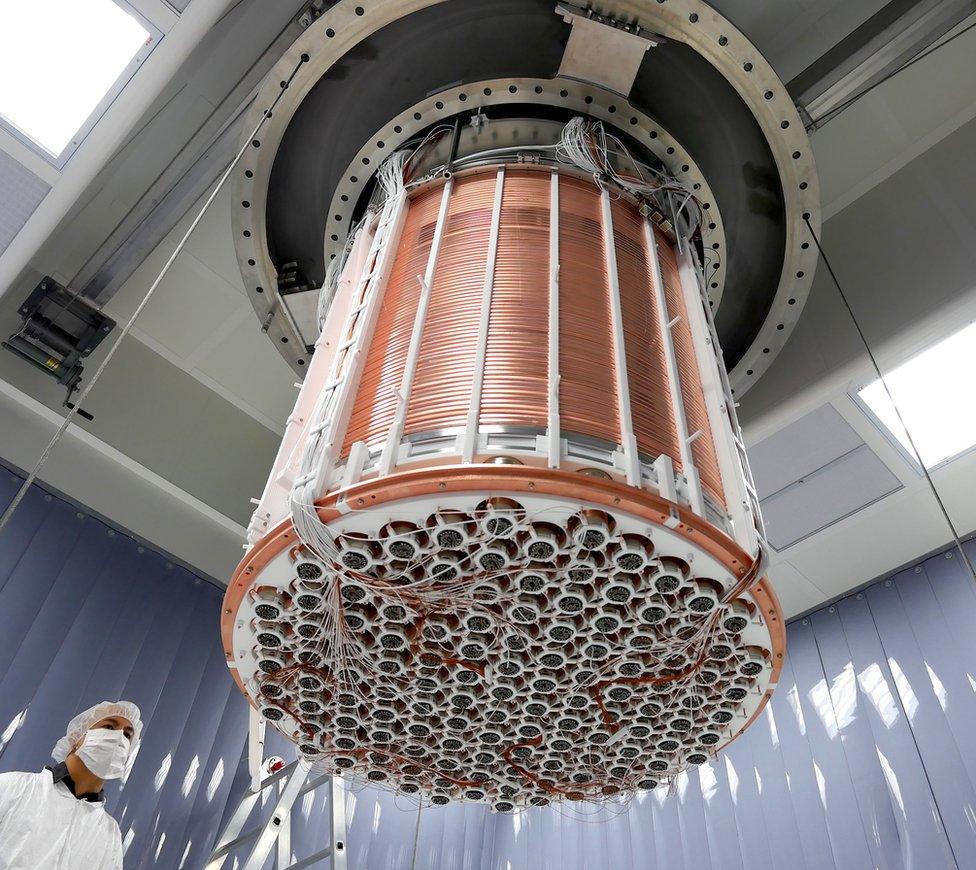Dark matter hunt yields unexplained signal
- Published

The Xenon1T detector was installed at Italy's Gran Sasso lab from 2016 to 2018

An experiment searching for signs of elusive dark matter has detected an unexplained signal.
Scientists working on the Xenon1T experiment have detected more activity within their detector than they would otherwise expect.
This "excess of events" could point to the existence of hypothesised particles called axions, some of which are candidates for dark matter.
Dark matter comprises 85% of matter in the cosmos, but its nature is unknown.
Whatever it is, it does not reflect or emit detectable light, hence the name.
There are three potential explanations for the new signal from the Xenon1T experiment. Two require new physics to explain, while one of them is consistent with the existence of solar axion particles.
The findings, which have not been peer reviewed, were published on the Arxiv pre-print server., external
So far, scientists have only observed indirect evidence of dark matter. A definitive, direct detection of dark matter particles has yet to be made.
There are several theories to account for what that particle might be like. The most favoured one has been the WIMP, or Weakly Interacting Massive Particle.
Physicists working on the Xenon series of experiments have spent more than a decade hunting for signs of these WIMPs. But the search has been fruitless.
But Xenon1T, the most recent iteration was also sensitive to other candidate particles.
Background noise
The experiment was operated deep underground at the Gran Sasso facility in Italy, from 2016 to 2018.
Its detector was filled with 3.2 tonnes of ultra-pure liquefied xenon, two tonnes of which served as a "target" for interactions between the xenon atoms and other particles that were passing through.
When a particle crosses the target, it can generate tiny flashes of light and free electrons from a xenon atom.
Most of these interactions - also known as events - are with particles we already know about, such as muons, cosmic rays and neutrinos. This constitutes what scientists refer to as the background signal.

Indirect evidence for dark matter: the titanic collision of two galaxy clusters separates dark matter (blue) from ordinary matter (pink)
A potential signal from an undiscovered particle needs to be strong enough to rise above this background noise.
Scientists carefully estimated the number of background events in Xenon1T. They expected to see roughly 232, but the experiment instead saw 285 - an excess of 53 events.
One explanation could be a new, previously unconsidered source of background contamination, caused by the presence of tiny amounts of tritium in the Xenon1T detector.
It could also be due to neutrinos, trillions of which pass through your body, unhindered, every second. One explanation could be that the magnetic moment (a property of all particles) of neutrinos is larger than its value in the Standard Model, which categorises the elementary particles in physics.
New physics
This would be a strong hint that some other new physics is needed to explain it.
However, the excess is most consistent with a signal from axions, a very light as-yet undetected class of particle. In fact, the excess of events has an energy spectrum similar to that expected from axions produced in the Sun.
While these solar axions are not dark matter candidates, axions produced in the early Universe could be a source of dark matter.
In statistical terms, the solar axion hypothesis has a significance of 3.5 sigma.
While this significance is fairly high, it is not large enough to conclude that axions exist. Five sigma is generally the accepted threshold for a discovery.
The significance of both the tritium and neutrino magnetic moment hypotheses corresponds to 3.2 sigma, meaning that they are also consistent with the data.
Scientists working on the Xenon collaboration are currently upgrading to a different iteration called Xenon-nT. With better data from this future version, they are confident they will soon find out whether the excess is a statistical fluke, a background contaminant, or something far more exciting.
Follow Paul on Twitter., external